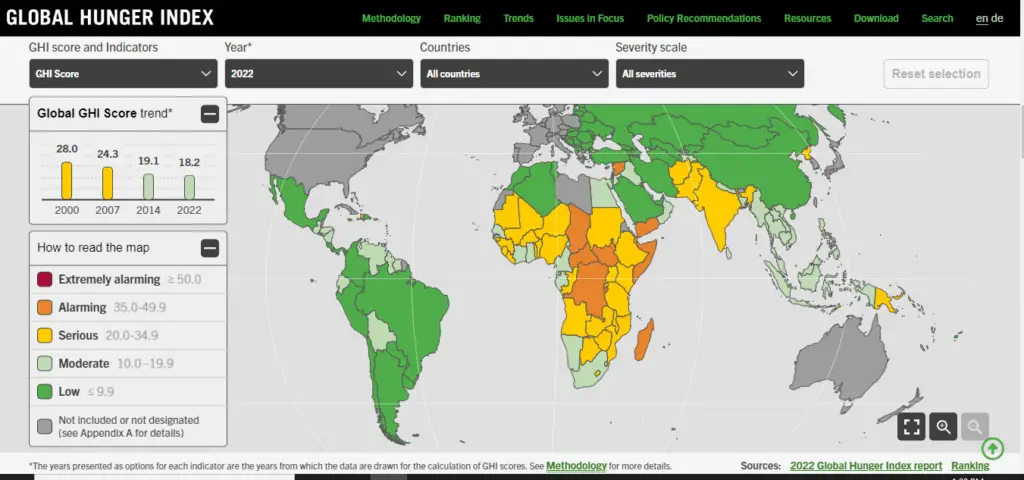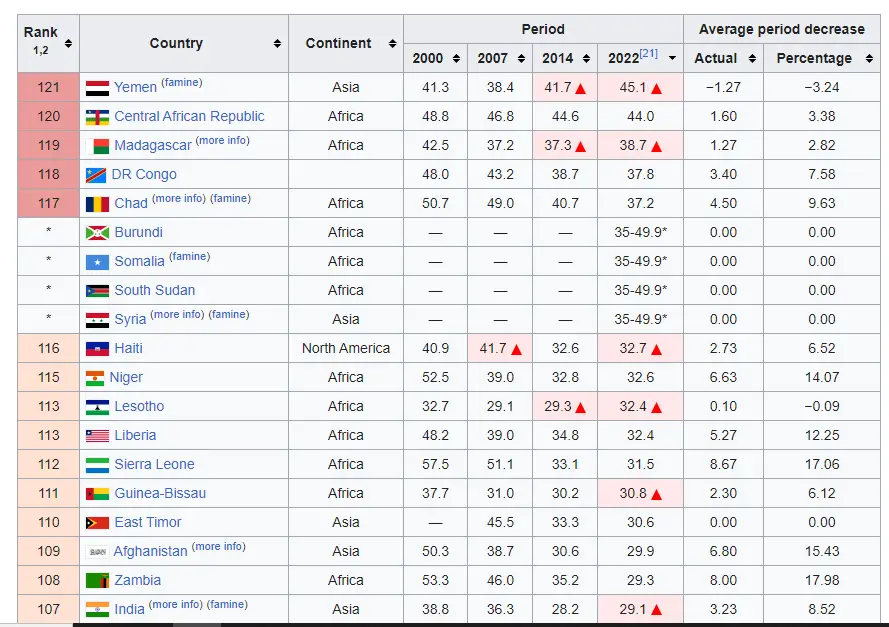In today’s global economy, developing nations play a crucial role in shaping the world we live in; for example, because of the high population growth rate, they form the majority of the immigrant population in developed nations; their economies have notable common features. These developing countries characteristics are responsible for the technological backwardness and many other challenges that prevent them from achieving rapid economic growth. We will explain these unique characteristics of developing countries, their effects, and examples.
What are developing countries?
Developing countries are also called “Underdeveloped countries” or “Less Developed Countries“. A developing country is a nation that has not yet achieved high levels of economic, human, and social development. These countries are typically characterized by low-income levels, limited access to healthcare and education, and infrastructure challenges such as poor road networks or lack of clean water systems.
In contrast to developed nations like the United States or Japan, developing countries often have higher rates of poverty, unemployment, and infant mortality.
One way to measure a country’s level of development is through the Human Development Index (HDI), which takes into account factors such as life expectancy at birth, years of schooling, and Gross Domestic Product (GDP) per capita.
Developing Countries Characteristics
- High poverty rate and inequality
- Low standards of living
- Low gross domestic product (GDP)
- High unemployment
- High dependency on subsistence agriculture
- Inadequate infrastructure
- Existence of a dualistic economy
- Existence of weak institutions
High poverty rate and inequality
One of the defining characteristics of developing countries is a high poverty rate. A large portion of the population lives below the poverty line with limited access to basic needs like food, water, and shelter. Multidimensional poverty is high in developing countries.
The high poverty rate affects the economic growth of these nations because it denies most citizens access to quality education. It also leads to systemic inequalities, inadequate access to healthcare facilities, and an inability to secure employment opportunities.
For example, Nigeria is one of the developing nations with more than 63% of its population multidimensionally poor as of 2022. With a population of more than 200 million people, 133 million of them are multidimensionally poor. This shows these people live in extreme monetary poverty (unable to spend more than 2.15 dollars per day), and have no access to education and basic infrastructure services.

From the picture below, all countries with extreme hunger are developing countries. Examples of these developing nations include Yemen, Central African Republic, Madagascar, etc.

Lower standards of living
Another characteristic of developing countries is the low standard of living observed in these nations. This means the majority of people lack access to basic human needs such as food, housing, and healthcare.
The low standard of living in underdeveloped countries can be attributed to a multitude of factors that are intrinsic to the characteristics of these nations; for example, they lack the necessary infrastructure and resources needed for economic development, which hinders their ability to provide basic necessities such as healthcare, education, and access to clean water.
Another reason for the low standard of living is the prevalence of corrupt governance systems that further exacerbates this situation by diverting funds away from public services toward the pockets of those in power. Additionally, the high levels of poverty and inequality present in these countries causes limited social mobility or opportunities for individuals to improve their socioeconomic status.
Low gross domestic product (GDP)
Developing countries exhibit several characteristics that can contribute to their low gross domestic product (GDP). The low GDP in these countries can partially be attributable to the high levels of poverty, limited infrastructure, and inadequate access to resources. These nations often struggle with weak economies that are highly dependent on a narrow range of industries, such as agriculture or mining, which can be susceptible to fluctuations in global markets.
Political instability and high levels of corruption are also commonly observed traits in developing nations, further hindered by subpar governance systems which fail to effectively allocate resources towards economic development initiatives.
Overall, these factors combine to create considerable challenges for achieving sustained growth rates for GDPs within developing countries which must be addressed through comprehensive policy changes aimed at improving institutional frameworks, allowing greater private sector participation while investing significantly in public institutions and also protecting people’s rights universally so they can get better opportunities.
See Also: What is Frictional Unemployment? Examples and Effects
High unemployment
A high unemployment rate is a common characteristic of developing countries. The fundamental cause of high unemployment rates in underdeveloped nations is the slow pace of industrialization and lack of access to education and training programs, which leads to an inadequate pool of skilled labor force. This results in high rates of joblessness, underemployment, or low-paying jobs for those who are employed, making it difficult to tackle poverty and improve living standards for the majority.
As explained above, the vicious circle of poverty that characterizes developing economies illustrates how the absence of gainful job opportunities and declining incomes erode living standards, limit economic prospects, and curtail social mobility.
High levels of unemployment in developing nations come at a high cost to households; when workers lose jobs or are never able to secure one, their purchasing power declines as their access to housing, healthcare, education, and basic goods deteriorates.
When there are more unemployed than employed people in a country, it leads to less spending power since the demand for goods and services reduces in turn affecting businesses as they may not be able to sell their products or make profits, thereby impeding the ability of these enterprises to invest significantly by introducing new technology. The effect of this is a limitation in job opportunities which enhances the vicious cycle that increases unemployment levels even further.
The end result of all these factors affecting developing nations is economic downturn which leads to higher welfare bills due to government subsidies being introduced as safety nets when individuals become deprived of basic necessities like food, shelter, education, and healthcare – putting undue stress on already-strained government finances thereby resulting in reduced capacity for long-term sustainable investments making socioeconomic planning ever more difficult.
High dependency on subsistence agriculture and the primary sector
Because of the high rate of poverty and unemployment that characterizes developing countries, there is also a high dependency on subsistence agriculture and the primary sector because most people rely on subsistence agriculture as their primary employment source since other industries have limited opportunities due to their capital-intensive nature, further exacerbating income disparity between urban and rural areas.
Inadequate infrastructure
Another characteristic of developing countries is inadequate infrastructure. These inadequate infrastructural systems impede economic growth. For example, a lack of efficient transportation networks, electricity grids, water supply systems, and other basic amenities can lead to increased costs for businesses operating within these economies. Also, poor infrastructure often results in reduced productivity levels and limited access to markets or customers which stifles economic growth.
Inadequate infrastructure, as a characteristic of developing nations, also hampers the provision of essential public services such as health care and education which are crucial for human capital development that drives economic prosperity. This suboptimal situation creates a vicious cycle where underdeveloped infrastructural capacity leads to slower rates of accumulation of physical and financial capital required for sustainable future growth.
Poor transportation networks can hinder trade while unreliable power grids limit industrial production capacity. For example, developing countries like Tanzania, Niger, Sierra Leone, etc, have more than 14% of their population without access to electricity.
Most underdeveloped nations have unreliable electricity to such an extent that industries and factories cannot rely on the power supply to function; it means the industries would have to generate their own power, increasing the cost of manufacturing.
As a result of the poor infrastructure, not many businesses or factories thrive and therefore, the output is low. The negative effect of this results in another characteristic of developing countries, which is, low industrial activity.
In contrast, developed countries have good infrastructure, which translates to economic prosperity compared to developing countries. Therefore, improving infrastructure is vital for achieving stable long-term economic progress.
Existence of a dualistic economy
The characteristics of developing countries are typically associated with the presence of a dualistic economy, whereby two distinct sectors exist side by side; one sector would be modern and globally integrated, while the other would be traditional and localized.
Dualistic economies represent systemic disparities perpetuating poverty leading not just to short-term negative effects but causing long-lasting shifts in social identity – impacting education levels, and income inequality making upward mobility difficult- all contributing towards further instability.
For example, in Nigeria, the rural areas are localized and traditional. Farming is done with manual equipment and is mostly subsistence in nature. The roads to these rural areas are bad, their sources of drinking water are mostly from wells that are not clean, etc.
In contrast to the rural areas, the urban areas such as the central parts of Lagos and Abuja are modern and globally integrated; these urban areas have access to banks, social amenities, accessible roads, electricity, and some industries. The overall effect of a dualistic economy is inequality in access to resources, opportunities, and standards of living which can lead to social unrest, political instability, and economic stagnation.
Existence of weak institutions
One of the defining characteristics of developing countries is their weak institutions, which have significant consequences for their societies and economies. Weak institutions can manifest in various ways, including corruption, lack of accountability, poor governance structures, and inadequate legal frameworks. These issues undermine social trust and hinder economic growth by creating barriers to investment, trade, and innovation.
For example, political instability resulting from a lack of effective governance has plagued many African nations such as Somalia or Zimbabwe leading to high levels of poverty and low levels of human development indicators like education or healthcare infrastructure investment. Additionally, Government regulation that lacks transparency or an independent judiciary system that fails to uphold rule-of-law principles can discourage foreign investors who are looking to do business in developing countries but don’t want the risk associated with corrupt officials abusing power.
Table showing Developing Nations Characteristics and how the economy is affected
| Characteristics of developing countries | This can lead to food insecurity, low productivity, and an inability to generate income from other sources. |
|---|---|
| High poverty rate and inequality | – Leads to lower consumer spending and lower economic growth. – It may also cause social and political instability. |
| Lower standards of living | Limits access to resources, weakens the domestic market, and hinders economic development. |
| Low gross domestic product (GDP) | Indicates that the nation’s economy is not producing enough goods and services to improve the standard of living of its citizens. |
| High unemployment | Reduces consumer spending, limits economic growth, and leads to social and political unrest. |
| High dependency on subsistence agriculture | Can lead to food insecurity, low productivity, and an inability to generate income from other sources. |
| Inadequate infrastructure | Hinders economic growth, productivity, and competitiveness, as well as limits access to markets, technology, and public services. |
Nansel is a serial entrepreneur and financial expert with 7+ years as a business analyst. He has a liking for marketing which he regards as an important part of business success.
He lives in Plateau State, Nigeria with his wife, Joyce, and daughter, Anael.
